Paper Menu >>
Journal Menu >>
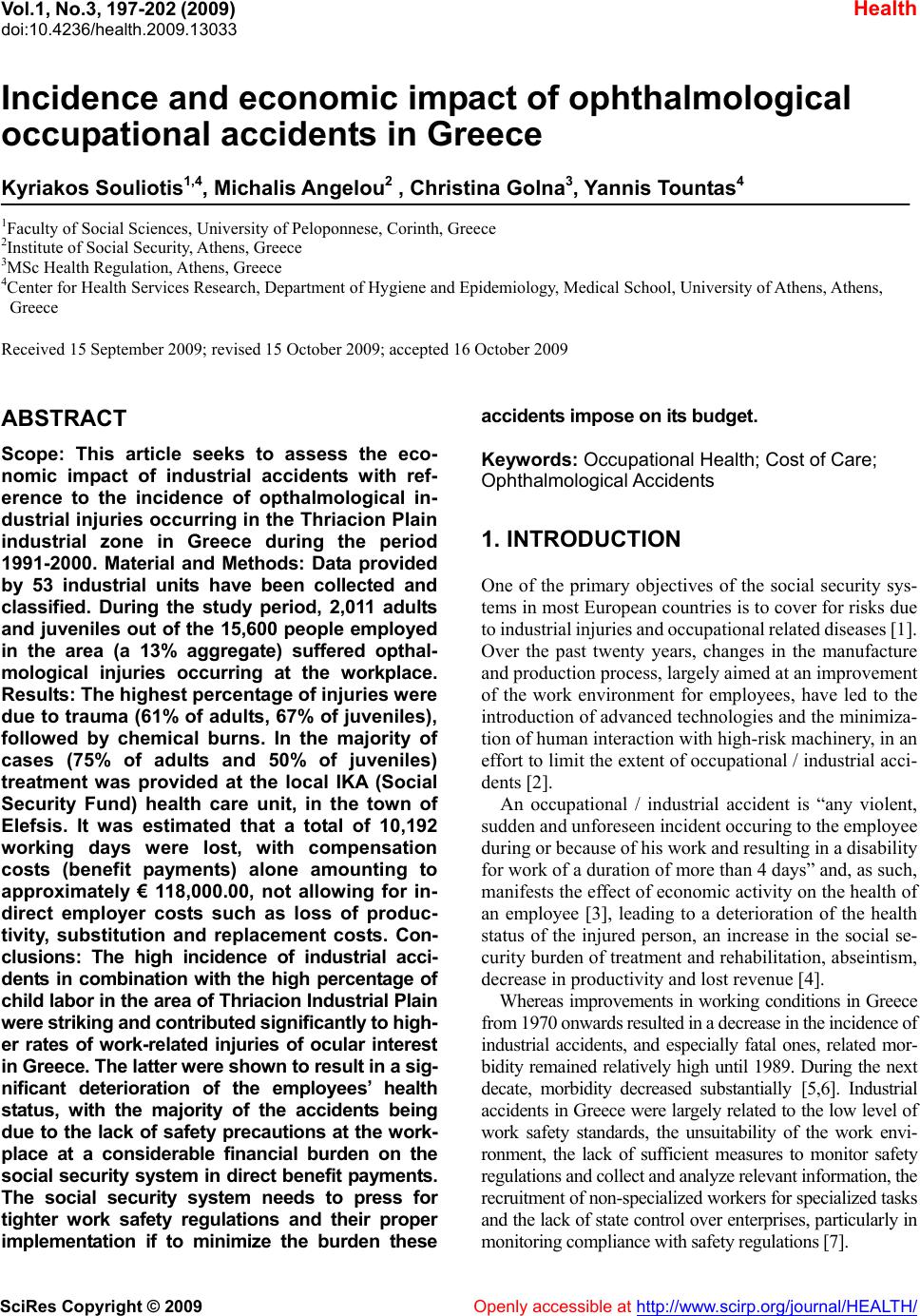 Vol.1, No.3, 197-202 (2009) doi:10.4236/health.2009.13033 SciRes Copyright © 2009 Openly accessible at http://www.scirp.org/journal/HEALTH/ Health Incidence and economic impact of ophthalmological occupational accidents in Greece Kyriakos Souliotis1,4, Michalis Angelou2 , Christina Golna3, Yannis Tountas4 1Faculty of Social Sciences, University of Peloponnese, Corinth, Greece 2Institute of Social Security, Athens, Greece 3MSc Health Regulation, Athens, Greece 4Center for Health Services Research, Department of Hygiene and Epidemiology, Medical School, University of Athens, Athens, Greece Received 15 September 2009; revised 15 October 2009; accepted 16 October 2009 ABSTRACT Scope: This article seeks to assess the eco- nomic impact of industrial accidents with ref- erence to the incidence of opthalmological in- dustrial injuries occurring in the Thriacion Plain industrial zone in Greece during the period 1991-2000. Material and Methods: Data provided by 53 industrial units have been collected and classified. During the study period, 2,011 adults and juveniles out of the 15,600 people employed in the area (a 13% aggregate) suffered opthal- mological injuries occurring at the workplace. Results: The highest percentage of injuries were due to trauma (61% of adults, 67% of juveniles), followed by chemical burns. In the majority of cases (75% of adults and 50% of juveniles) treatment was provided at the local IKA (Social Security Fund) health care unit, in the town of Elefsis. It was estimated that a total of 10,192 working days were lost, with compensation costs (benefit payments) alone amounting to approximately € 118,000.00, not allowing for in- direct employer costs such as loss of produc- tivity, substitution and replacement costs. Con- clusions: The high incidence of industrial acci- dents in combination with the high percentage of child labor in the area of Thriacion Industrial Plain were striking and contributed significantly to high- er rates of work-related injuries of ocular interest in Greece. The latter were shown to result in a sig- nificant deterioration of the employees’ health status, with the majority of the accidents being due to the lack of safety precautions at the work- place at a considerable financial burden on the social security system in direct benefit payments. The social security system needs to press for tighter work safety regulations and their proper implementation if to minimize the burden these accidents impose on its budget. Keywords: Occupational Health; Cost of Care; Ophthalmological Accidents 1. INTRODUCTION One of the primary objectives of the social security sys- tems in most European countries is to cover for risks due to industrial injuries and occupational related diseases [1]. Over the past twenty years, changes in the manufacture and production process, largely aimed at an improvement of the work environment for employees, have led to the introduction of advanced technologies and the minimiza- tion of human interaction with high-risk machinery, in an effort to limit the extent of occupational / industrial acci- dents [2]. An occupational / industrial accident is “any violent, sudden and unforeseen incident occuring to the employee during or because of his work and resulting in a disability for work of a duration of more than 4 days” and, as such, manifests the effect of economic activity on the health of an employee [3], leading to a deterioration of the health status of the injured person, an increase in the social se- curity burden of treatment and rehabilitation, abseintism, decrease in productivity and lost revenue [4]. Whereas improvements in working conditions in Greece from 1970 onwards resulted in a decrease in the incidence of industrial accidents, and especially fatal ones, related mor- bidity remained relatively high until 1989. During the next decate, morbidity decreased substantially [5,6]. Industrial accidents in Greece were largely related to the low level of work safety standards, the unsuitability of the work envi- ronment, the lack of sufficient measures to monitor safety regulations and collect and analyze relevant information, the recruitment of non-specialized workers for specialized tasks and the lack of state control over enterprises, particularly in monitoring compliance with safety regulations [7]. 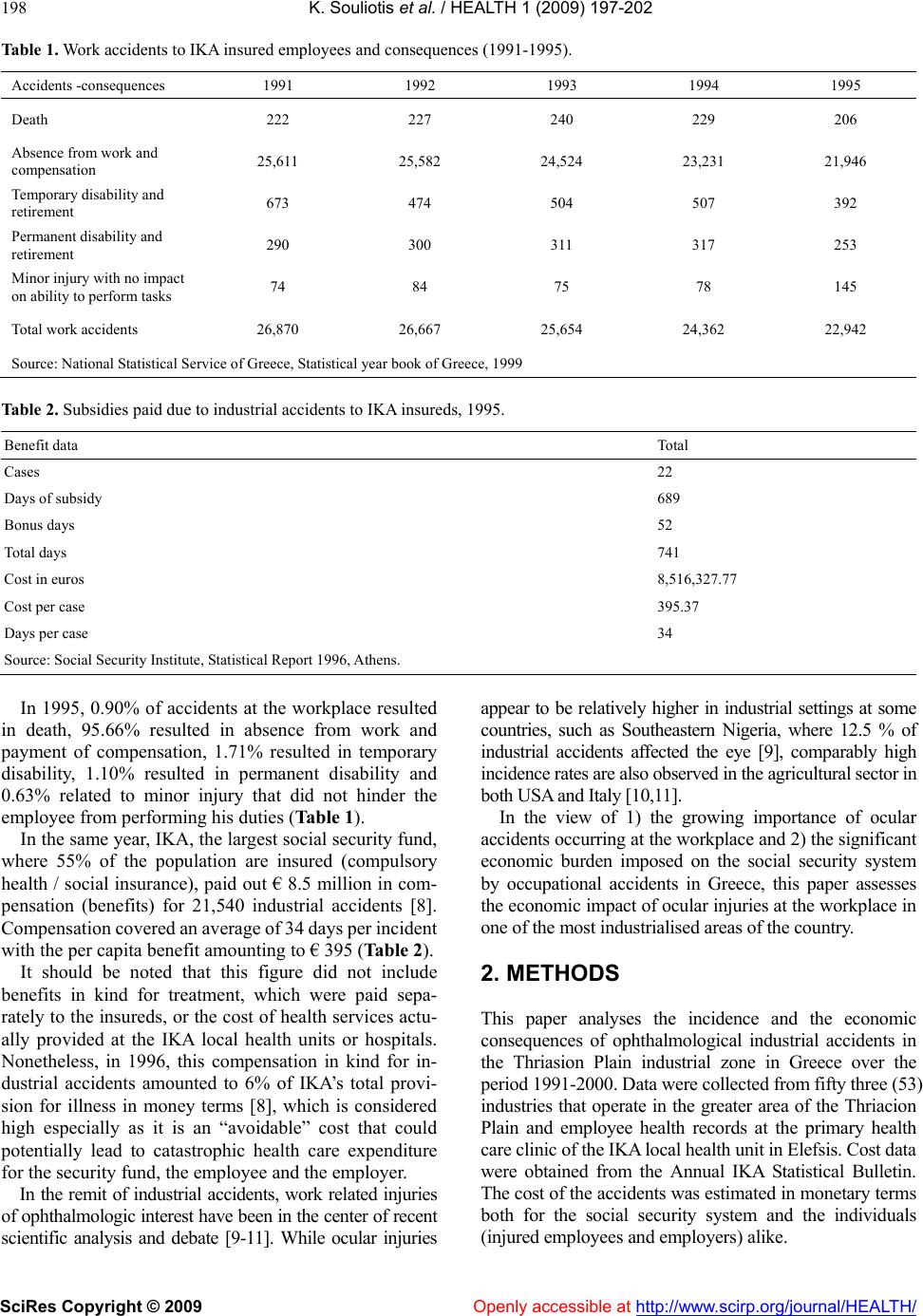 198 K. Souliotis et al. / HEALTH 1 (2009) 197-202 SciRes Copyright © 2009 http://www.scirp.org/journal/HEALTH/Openly accessible at Table 1. Work accidents to IKA insured employees and consequences (1991-1995). Accidents -consequences 1991 1992 1993 1994 1995 Death 222 227 240 229 206 Absence from work and compensation 25,611 25,582 24,524 23,231 21,946 Temporary disability and retirement 673 474 504 507 392 Permanent disability and retirement 290 300 311 317 253 Minor injury with no impact on ability to perform tasks 74 84 75 78 145 Total work accidents 26,870 26,667 25,654 24,362 22,942 Source: National Statistical Service of Greece, Statistical year book of Greece, 1999 Table 2. Subsidies paid due to industrial accidents to IKA insureds, 1995. Benefit data Total Cases 22 Days of subsidy 689 Bonus days 52 Total days 741 Cost in euros 8,516,327.77 Cost per case 395.37 Days per case 34 Source: Social Security Institute, Statistical Report 1996, Athens. In 1995, 0.90% of accidents at the workplace resulted in death, 95.66% resulted in absence from work and payment of compensation, 1.71% resulted in temporary disability, 1.10% resulted in permanent disability and 0.63% related to minor injury that did not hinder the employee from performing his duties (Table 1). In the same year, IKA, the largest social security fund, where 55% of the population are insured (compulsory health / social insurance), paid out € 8.5 million in com- pensation (benefits) for 21,540 industrial accidents [8]. Compensation covered an average of 34 days per incident with the per capita benefit amounting to € 395 (Table 2). It should be noted that this figure did not include benefits in kind for treatment, which were paid sepa- rately to the insureds, or the cost of health services actu- ally provided at the IKA local health units or hospitals. Nonetheless, in 1996, this compensation in kind for in- dustrial accidents amounted to 6% of IKA’s total provi- sion for illness in money terms [8], which is considered high especially as it is an “avoidable” cost that could potentially lead to catastrophic health care expenditure for the security fund, the employee and the employer. In the remit of industrial accidents, work related injuries of ophthalmologic interest have been in the center of recent scientific analysis and debate [9-11]. While ocular injuries appear to be relatively higher in industrial settings at some countries, such as Southeastern Nigeria, where 12.5 % of industrial accidents affected the eye [9], comparably high incidence rates are also observed in the agricultural sector in both USA and Italy [10,11]. In the view of 1) the growing importance of ocular accidents occurring at the workplace and 2) the significant economic burden imposed on the social security system by occupational accidents in Greece, this paper assesses the economic impact of ocular injuries at the workplace in one of the most industrialised areas of the country. 2. METHODS This paper analyses the incidence and the economic consequences of ophthalmological industrial accidents in the Thriasion Plain industrial zone in Greece over the period 1991-2000. Data were collected from fifty three (53) industries that operate in the greater area of the Thriacion Plain and employee health records at the primary health care clinic of the IKA local health unit in Elefsis. Cost data were obtained from the Annual IKA Statistical Bulletin. The cost of the accidents was estimated in monetary terms both for the social security system and the individuals (injured employees and employers) alike. 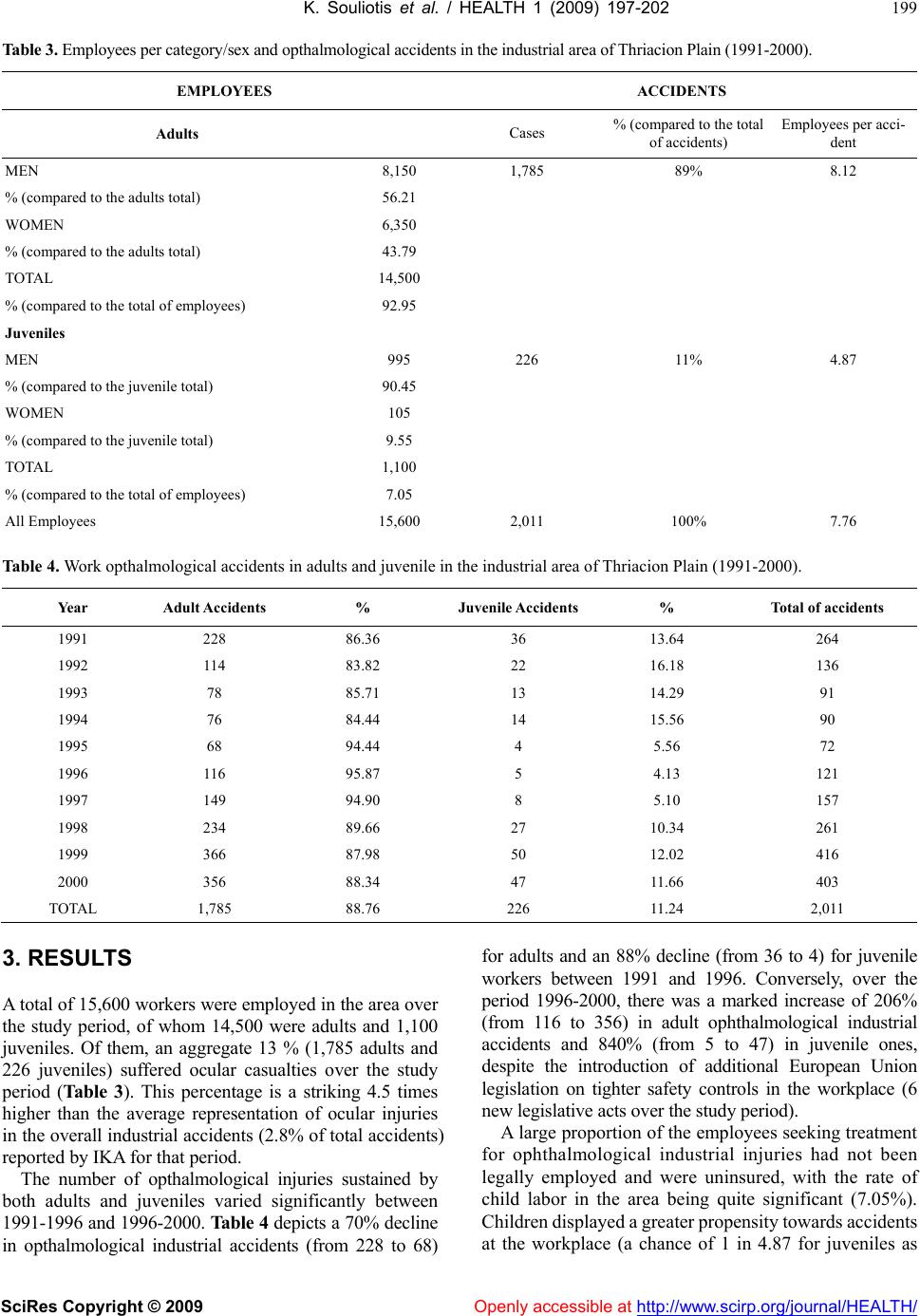 K. Souliotis et al. / HEALTH 1 (2009) 197-202 199 SciRes Copyright © 2009 Openly accessible at http://www.scirp.org/journal/HEALTH/ Table 3. Employees per category/sex and opthalmological accidents in the industrial area of Thriacion Plain (1991-2000). EMPLOYEES ACCIDENTS Adults Cases % (compared to the total of accidents) Employees per acci- dent MEN 8,150 1,785 89% 8.12 % (compared to the adults total) 56.21 WOMEN 6,350 % (compared to the adults total) 43.79 TOTAL 14,500 % (compared to the total of employees) 92.95 Juveniles MEN 995 226 11% 4.87 % (compared to the juvenile total) 90.45 WOMEN 105 % (compared to the juvenile total) 9.55 TOTAL 1,100 % (compared to the total of employees) 7.05 All Employees 15,600 2,011 100% 7.76 Table 4. Work opthalmological accidents in adults and juvenile in the industrial area of Thriacion Plain (1991-2000). Year Adult Accidents % Juvenile Accidents % Total of accidents 1991 228 86.36 36 13.64 264 1992 114 83.82 22 16.18 136 1993 78 85.71 13 14.29 91 1994 76 84.44 14 15.56 90 1995 68 94.44 4 5.56 72 1996 116 95.87 5 4.13 121 1997 149 94.90 8 5.10 157 1998 234 89.66 27 10.34 261 1999 366 87.98 50 12.02 416 2000 356 88.34 47 11.66 403 TOTAL 1,785 88.76 226 11.24 2,011 3. RESULTS A total of 15,600 workers were employed in the area over the study period, of whom 14,500 were adults and 1,100 juveniles. Of them, an aggregate 13 % (1,785 adults and 226 juveniles) suffered ocular casualties over the study period (Table 3). This percentage is a striking 4.5 times higher than the average representation of ocular injuries in the overall industrial accidents (2.8% of total accidents) reported by IKA for that period. The number of opthalmological injuries sustained by both adults and juveniles varied significantly between 1991-1996 and 1996-2000. Table 4 depicts a 70% decline in opthalmological industrial accidents (from 228 to 68) for adults and an 88% decline (from 36 to 4) for juvenile workers between 1991 and 1996. Conversely, over the period 1996-2000, there was a marked increase of 206% (from 116 to 356) in adult ophthalmological industrial accidents and 840% (from 5 to 47) in juvenile ones, despite the introduction of additional European Union legislation on tighter safety controls in the workplace (6 new legislative acts over the study period). A large proportion of the employees seeking treatment for ophthalmological industrial injuries had not been legally employed and were uninsured, with the rate of child labor in the area being quite significant (7.05%). Children displayed a greater propensity towards accidents at the workplace (a chance of 1 in 4.87 for juveniles as 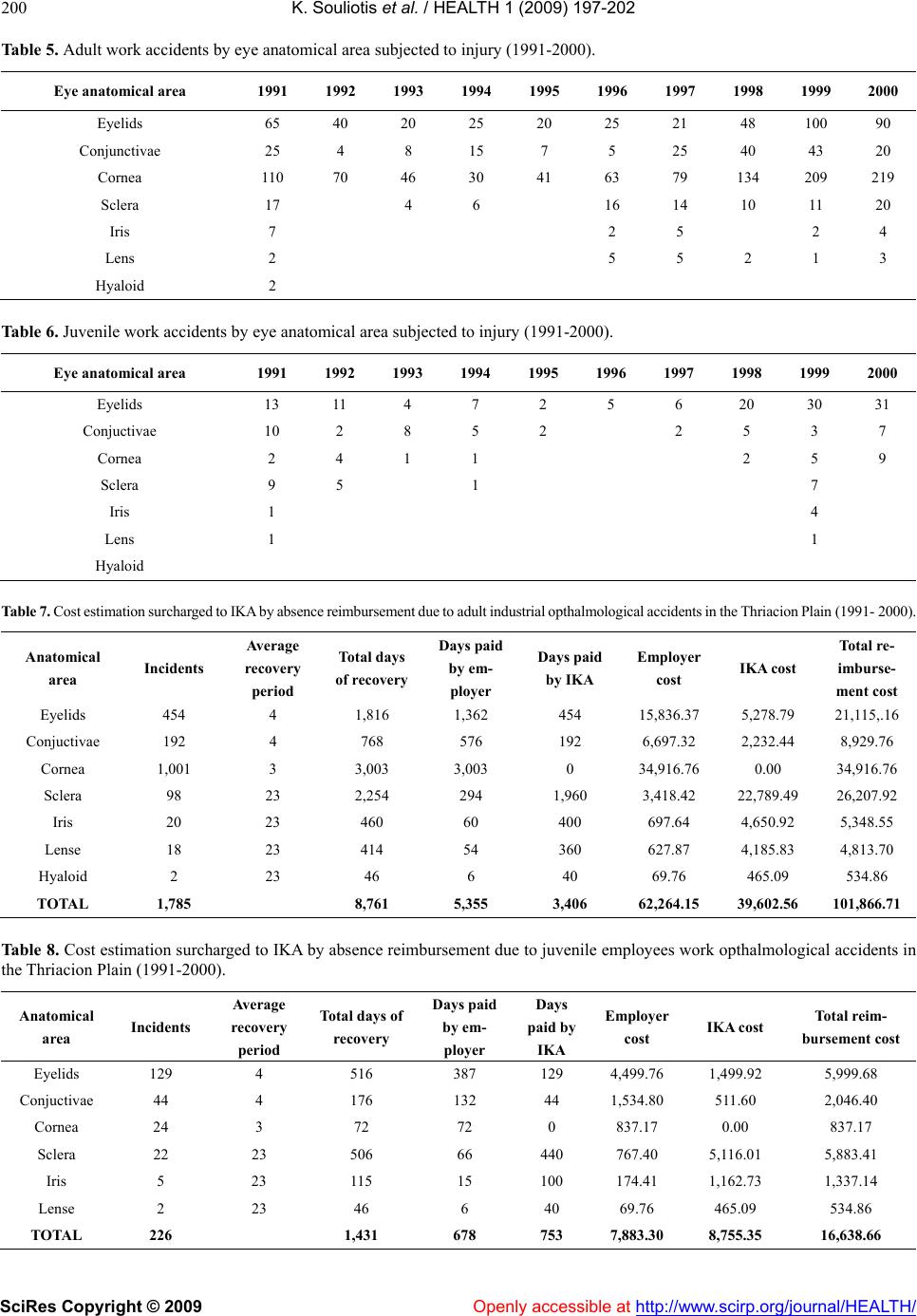 200 K. Souliotis et al. / HEALTH 1 (2009) 197-202 SciRes Copyright © 2009 Openly accessible at http://www.scirp.org/journal/HEALTH/ Table 5. Adult work accidents by eye anatomical area subjected to injury (1991-2000). Eye anatomical area 1991 1992 1993 1994 1995 1996 1997 1998 1999 2000 Eyelids 65 40 20 25 20 25 21 48 100 90 Conjunctivae 25 4 8 15 7 5 25 40 43 20 Cornea 110 70 46 30 41 63 79 134 209 219 Sclera 17 4 6 16 14 10 11 20 Iris 7 2 5 2 4 Lens 2 5 5 2 1 3 Hyaloid 2 Table 6. Juvenile work accidents by eye anatomical area subjected to injury (1991-2000). Eye anatomical area 1991 1992 1993 1994 1995 1996 1997 1998 1999 2000 Eyelids 13 11 4 7 2 5 6 20 30 31 Conjuctivae 10 2 8 5 2 2 5 3 7 Cornea 2 4 1 1 2 5 9 Sclera 9 5 1 7 Iris 1 4 Lens 1 1 Hyaloid Table 7. Cost estimation surcharged to IKA by absence reimbursement due to adult industrial opthalmological accidents in the Thriacion Plain (1991- 2000). Anatomical area Incidents Average recovery period Total days of recovery Days paid by em- ployer Days paid by IKA Employer cost IKA cost Total re- imburse- ment cost Eyelids 454 4 1,816 1,362 454 15,836.37 5,278.79 21,115,.16 Conjuctivae 192 4 768 576 192 6,697.32 2,232.44 8,929.76 Cornea 1,001 3 3,003 3,003 0 34,916.76 0.00 34,916.76 Sclera 98 23 2,254 294 1,960 3,418.42 22,789.49 26,207.92 Iris 20 23 460 60 400 697.64 4,650.92 5,348.55 Lense 18 23 414 54 360 627.87 4,185.83 4,813.70 Hyaloid 2 23 46 6 40 69.76 465.09 534.86 TOTAL 1,785 8,761 5,355 3,406 62,264.15 39,602.56 101,866.71 Table 8. Cost estimation surcharged to IKA by absence reimbursement due to juvenile employees work opthalmological accidents in the Thriacion Plain (1991-2000). Anatomical area Incidents Average recovery period Total days of recovery Days paid by em- ployer Days paid by IKA Employer cost IKA cost Total reim- bursement cost Eyelids 129 4 516 387 129 4,499.76 1,499.92 5,999.68 Conjuctivae 44 4 176 132 44 1,534.80 511.60 2,046.40 Cornea 24 3 72 72 0 837.17 0.00 837.17 Sclera 22 23 506 66 440 767.40 5,116.01 5,883.41 Iris 5 23 115 15 100 174.41 1,162.73 1,337.14 Lense 2 23 46 6 40 69.76 465.09 534.86 TOTAL 226 1,431 678 753 7,883.30 8,755.35 16,638.66 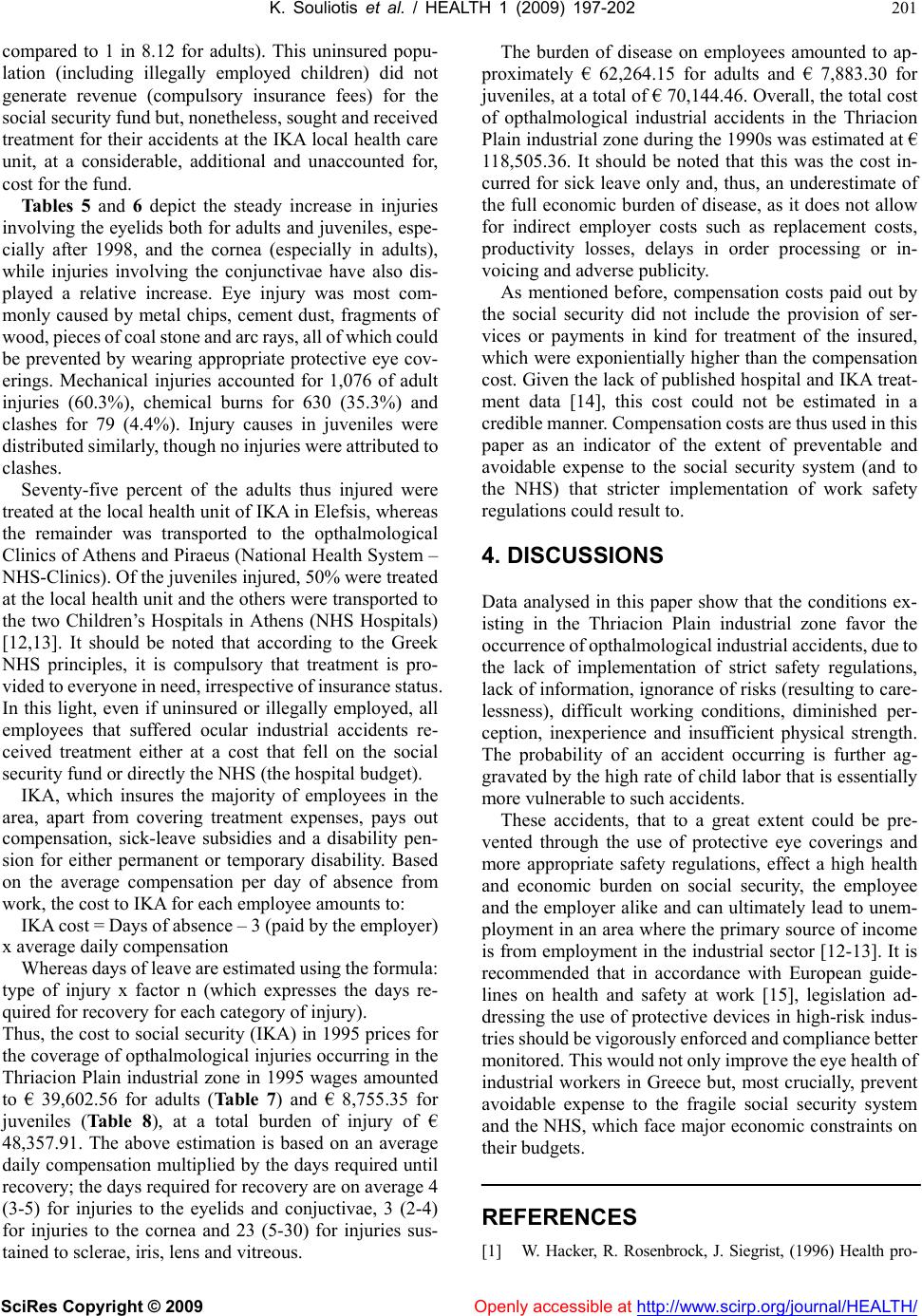 K. Souliotis et al. / HEALTH 1 (2009) 197-202 201 SciRes Copyright © 2009 Openly accessible at http://www.scirp.org/journal/HEALTH/ compared to 1 in 8.12 for adults). This uninsured popu- lation (including illegally employed children) did not generate revenue (compulsory insurance fees) for the social security fund but, nonetheless, sought and received treatment for their accidents at the IKA local health care unit, at a considerable, additional and unaccounted for, cost for the fund. Tables 5 and 6 depict the steady increase in injuries involving the eyelids both for adults and juveniles, espe- cially after 1998, and the cornea (especially in adults), while injuries involving the conjunctivae have also dis- played a relative increase. Eye injury was most com- monly caused by metal chips, cement dust, fragments of wood, pieces of coal stone and arc rays, all of which could be prevented by wearing appropriate protective eye cov- erings. Mechanical injuries accounted for 1,076 of adult injuries (60.3%), chemical burns for 630 (35.3%) and clashes for 79 (4.4%). Injury causes in juveniles were distributed similarly, though no injuries were attributed to clashes. Seventy-five percent of the adults thus injured were treated at the local health unit of IKA in Elefsis, whereas the remainder was transported to the opthalmological Clinics of Athens and Piraeus (National Health System – NHS-Clinics). Of the juveniles injured, 50% were treated at the local health unit and the others were transported to the two Children’s Hospitals in Athens (NHS Hospitals) [12,13]. It should be noted that according to the Greek NHS principles, it is compulsory that treatment is pro- vided to everyone in need, irrespective of insurance status. In this light, even if uninsured or illegally employed, all employees that suffered ocular industrial accidents re- ceived treatment either at a cost that fell on the social security fund or directly the NHS (the hospital budget). IKA, which insures the majority of employees in the area, apart from covering treatment expenses, pays out compensation, sick-leave subsidies and a disability pen- sion for either permanent or temporary disability. Based on the average compensation per day of absence from work, the cost to IKA for each employee amounts to: IKA cost = Days of absence – 3 (paid by the employer) x average daily compensation Whereas days of leave are estimated using the formula: type of injury x factor n (which expresses the days re- quired for recovery for each category of injury). Thus, the cost to social security (IKA) in 1995 prices for the coverage of opthalmological injuries occurring in the Thriacion Plain industrial zone in 1995 wages amounted to € 39,602.56 for adults (Table 7) and € 8,755.35 for juveniles (Table 8), at a total burden of injury of € 48,357.91. The above estimation is based on an average daily compensation multiplied by the days required until recovery; the days required for recovery are on average 4 (3-5) for injuries to the eyelids and conjuctivae, 3 (2-4) for injuries to the cornea and 23 (5-30) for injuries sus- tained to sclerae, iris, lens and vitreous. The burden of disease on employees amounted to ap- proximately € 62,264.15 for adults and € 7,883.30 for juveniles, at a total of € 70,144.46. Overall, the total cost of opthalmological industrial accidents in the Thriacion Plain industrial zone during the 1990s was estimated at € 118,505.36. It should be noted that this was the cost in- curred for sick leave only and, thus, an underestimate of the full economic burden of disease, as it does not allow for indirect employer costs such as replacement costs, productivity losses, delays in order processing or in- voicing and adverse publicity. As mentioned before, compensation costs paid out by the social security did not include the provision of ser- vices or payments in kind for treatment of the insured, which were exponientially higher than the compensation cost. Given the lack of published hospital and IKA treat- ment data [14], this cost could not be estimated in a credible manner. Compensation costs are thus used in this paper as an indicator of the extent of preventable and avoidable expense to the social security system (and to the NHS) that stricter implementation of work safety regulations could result to. 4. DISCUSSIONS Data analysed in this paper show that the conditions ex- isting in the Thriacion Plain industrial zone favor the occurrence of opthalmological industrial accidents, due to the lack of implementation of strict safety regulations, lack of information, ignorance of risks (resulting to care- lessness), difficult working conditions, diminished per- ception, inexperience and insufficient physical strength. The probability of an accident occurring is further ag- gravated by the high rate of child labor that is essentially more vulnerable to such accidents. These accidents, that to a great extent could be pre- vented through the use of protective eye coverings and more appropriate safety regulations, effect a high health and economic burden on social security, the employee and the employer alike and can ultimately lead to unem- ployment in an area where the primary source of income is from employment in the industrial sector [12-13]. It is recommended that in accordance with European guide- lines on health and safety at work [15], legislation ad- dressing the use of protective devices in high-risk indus- tries should be vigorously enforced and compliance better monitored. This would not only improve the eye health of industrial workers in Greece but, most crucially, prevent avoidable expense to the fragile social security system and the NHS, which face major economic constraints on their budgets. REFERENCES [1] W. Hacker, R. Rosenbrock, J. Siegrist, (1996) Health pro- 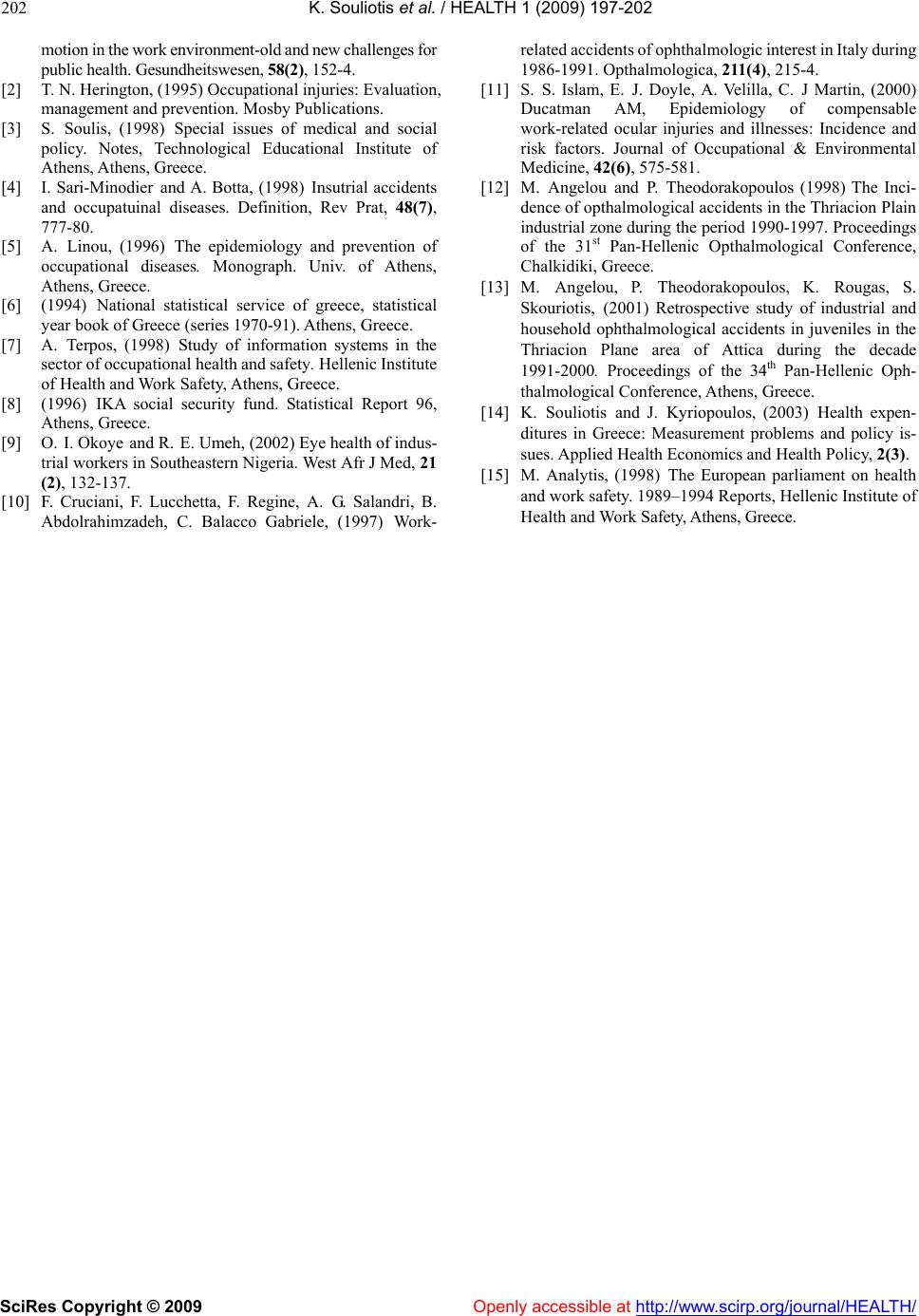 202 K. Souliotis et al. / HEALTH 1 (2009) 197-202 SciRes Copyright © 2009 http://www.scirp.org/journal/HEALTH/Openly accessible at motion in the work environment-old and new challenges for public health. Gesundheitswesen, 58(2), 152-4. [2] T. N. Herington, (1995) Occupational injuries: Evaluation, management and prevention. Mosby Publications. [3] S. Soulis, (1998) Special issues of medical and social policy. Notes, Technological Educational Institute of Athens, Athens, Greece. [4] I. Sari-Minodier and A. Botta, (1998) Insutrial accidents and occupatuinal diseases. Definition, Rev Prat, 48(7), 777-80. [5] A. Linou, (1996) The epidemiology and prevention of occupational diseases. Monograph. Univ. of Athens, Athens, Greece. [6] (1994) National statistical service of greece, statistical year book of Greece (series 1970-91). Athens, Greece. [7] A. Terpos, (1998) Study of information systems in the sector of occupational health and safety. Hellenic Institute of Health and Work Safety, Athens, Greece. [8] (1996) IKA social security fund. Statistical Report 96, Athens, Greece. [9] O. I. Okoye and R. E. Umeh, (2002) Eye health of indus- trial workers in Southeastern Nigeria. West Afr J Med, 21 (2), 132-137. [10] F. Cruciani, F. Lucchetta, F. Regine, A. G. Salandri, B. Abdolrahimzadeh, C. Balacco Gabriele, (1997) Work- related accidents of ophthalmologic interest in Italy during 1986-1991. Opthalmologica, 211(4), 215-4. [11] S. S. Islam, E. J. Doyle, A. Velilla, C. J Martin, (2000) Ducatman AM, Epidemiology of compensable work-related ocular injuries and illnesses: Incidence and risk factors. Journal of Occupational & Environmental Medicine, 42(6), 575-581. [12] M. Angelou and P. Theodorakopoulos (1998) The Inci- dence of opthalmological accidents in the Thriacion Plain industrial zone during the period 1990-1997. Proceedings of the 31st Pan-Hellenic Opthalmological Conference, Chalkidiki, Greece. [13] M. Angelou, P. Theodorakopoulos, K. Rougas, S. Skouriotis, (2001) Retrospective study of industrial and household ophthalmological accidents in juveniles in the Thriacion Plane area of Attica during the decade 1991-2000. Proceedings of the 34th Pan-Hellenic Oph- thalmological Conference, Athens, Greece. [14] K. Souliotis and J. Kyriopoulos, (2003) Health expen- ditures in Greece: Measurement problems and policy is- sues. Applied Health Economics and Health Policy, 2(3). [15] M. Analytis, (1998) The European parliament on health and work safety. 1989–1994 Reports, Hellenic Institute of Health and Work Safety, Athens, Greece. |

